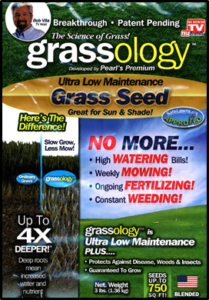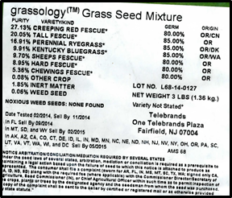Grassology! as Seen on TV!
go.ncsu.edu/readext?474941
en Español / em Português
El inglés es el idioma de control de esta página. En la medida en que haya algún conflicto entre la traducción al inglés y la traducción, el inglés prevalece.
Al hacer clic en el enlace de traducción se activa un servicio de traducción gratuito para convertir la página al español. Al igual que con cualquier traducción por Internet, la conversión no es sensible al contexto y puede que no traduzca el texto en su significado original. NC State Extension no garantiza la exactitud del texto traducido. Por favor, tenga en cuenta que algunas aplicaciones y/o servicios pueden no funcionar como se espera cuando se traducen.
Português
Inglês é o idioma de controle desta página. Na medida que haja algum conflito entre o texto original em Inglês e a tradução, o Inglês prevalece.
Ao clicar no link de tradução, um serviço gratuito de tradução será ativado para converter a página para o Português. Como em qualquer tradução pela internet, a conversão não é sensivel ao contexto e pode não ocorrer a tradução para o significado orginal. O serviço de Extensão da Carolina do Norte (NC State Extension) não garante a exatidão do texto traduzido. Por favor, observe que algumas funções ou serviços podem não funcionar como esperado após a tradução.
English
English is the controlling language of this page. To the extent there is any conflict between the English text and the translation, English controls.
Clicking on the translation link activates a free translation service to convert the page to Spanish. As with any Internet translation, the conversion is not context-sensitive and may not translate the text to its original meaning. NC State Extension does not guarantee the accuracy of the translated text. Please note that some applications and/or services may not function as expected when translated.
Collapse ▲POSTED WITH PERMISSION: http://turf.uark.edu/turfhelp/archives/042114_Grassology.html
University of Arkansas, Division of Agriculture
Over the past few weeks, we have gotten numerous inquiries about the latest wonder product for the turfgrass industry — Grassology (www.grassology.com). Their website promotes that you will get a “gorgeous lawn that’s virtually maintenance-free”. With this lawn, there will be “no more weekly mowing, no more ongoing fertilizing, no more high watering bills, and no more constant weeding”. Although it is primarily a TV and internet campaign, this product has also made its way into some of the big retail stores around the country, including our very own Walmart stores where we picked up a bag the other day (see Photo 1 below). Sounds great doesn’t it?? I mean, Bob Villa is promoting it, so it must be great!!
As is the case with most “miracle” products, it is always best to look at the real science behind the product before making a decision to try it. just because it is “seen on tv” or promoted by a paid spokesman like bob villa, does not mean that it will work as a lawn in nw arkansas or anywhere else in the world. when selecting grass seed, we always tell our students and people in the industry that the real information about the product is not found on the front of the bag, where claims of beautiful lawns and pictures of happy families are found, but on the back of the bag, where the state-mandated seed label is found. the seed label will tell you the percentage of each species in the bag, what cultivar of each species is in the bag, the germination percentage of each cultivar, and if any weeds are present.
When we look more closely at the seed label on Grassology (see Photo 2 below), what do we find? In this case, the seed mixture that was sold in NW Arkansas had creeping red fescue, tall fescue, perennial ryegrass, Kentucky bluegrass, Sheeps fescue and hard fescue — all cool-season grasses. Of these, tall fescue is the only one that is reasonably well-adapted to north Arkansas and some of the fine fescues are not adapted at all. They all had germination percentages of 80-85%, which is not bad, but it is also not great. The one piece of information that is missing from this label is the variety or cultivar of each species. Why is that? Well, it is missing because the grasses in this mixture are being sold as “variety not stated” or what is commonly called VNS. This designation is usually assigned to low-quality grass seed that could be any cultivar and would change from year to year based on availability and price. So, if you buy this product, you really have no idea if this is a good cultivar or a bad cultivar — our guess is that it will typically be a bad cultivar.
The last thing you need to know about this product is the price — in this case, we paid $21.12 (including sales tax) for a 3 lb. bag or about $7.00 / pound for the seed. When you compare this to elite mixtures of tall fescue that have highly developed, researched cultivars that sell for around $4.00 / lb., you can see that you are getting twice the bargain – a lower-quality product at a significantly higher price!! So, when you are enticed to buy grass seed based on the claims of a paid spokesman or miracle results, make sure you do a little research to find out if it is really backed by science or just backed by marketing.
If you want to find out about cultivars of turfgrass that do perform well in Arkansas and the surrounding region, please visit the National Turfgrass Evaluation Program website (www.ntep.org) and look at the data from our research program at the University of Arkansas in Fayetteville. There, you will likely find a grass that can reduce your mowing, reduce your water bills and provide a beautiful, healthy lawn.
Wishing you all a great start to your spring…
Mike Richardson and Doug Karcher
Department of Horticulture
University of Arkansas






